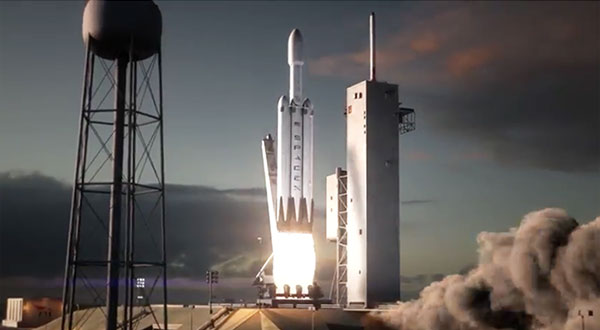SpaceX on Thursday released a computer-generated animation demonstrating how the three Falcon 9 cores of its Falcon Heavy rocket, scheduled for launch later this year, would return to Earth.
The boosters would land vertically at a selected site.
Trimming Costs
The Falcon Heavy will be the most powerful rocket in the world, being able to lift more than 53 metric tons, or 117,000 pounds, into low earth orbit. That’s equivalent to a Boeing 737 fully loaded with passengers, crew, luggage and fuel, and it is more than twice the payload of the next closest operational space vehicle, the Delta IV Heavy, SpaceX said.
Lifting that payload with the Falcon Heavy will cost just one-third of the cost of doing it with the Delta IV Heavy, according to SpaceX.
It will cost US$85 million to launch a payload of up to 14,100 pounds to geosynchronous transfer obit using the Falcon Heavy.
If the Falcon Heavy works as planned and can be recovered for reuse, “it could reduce the cost per kilo to transport [a payload] to orbit from millions of dollars to thousands,” said Mike Jude, manager of the Stratecast consumer communication services program at Frost & Sullivan.
The Falcon Heavy is a variant of the Falcon 9 v1.1. It will consist of three standard Falcon 9 nine-engine rocket cores with Merlin 1D engines, and two additional Falcon 9 strap-on first stages.
The Heavy stands 224 feet tall and is 38 feet wide. It has a mass of more than 3.2 million pounds. The Falcon Heavy’s maximum GTO payload is 46,700 pounds.
Crashing and Burning
SpaceX has been experimenting with rocket recovery, testing first-stage boosters that relight their engines to slow their descent through the atmosphere. They have fins to help their descent, and legs for a stable touchdown.
SpaceX’s attempt earlier this month to bring part of a Falcon 9 rocket down to a floating platform — a barge less than 100m wide — failed, in that the first stage hit the barge hard instead of making a controlled return. However, it was pitch dark and foggy at the time.
The fins “ran out of hydraulic fluid right before landing,” SpaceX CEO Elon Musk tweeted.
An attempt in August, using the prototype falcon 9 Reusable, failed when the vehicle blew up in mid-air over McGregor, Texas, after its instruments detected an anomaly.
Getting Rockets Down to Earth
“General Dynamics Space Systems was working on this idea in 1991,” said Jim McGregor, principal analyst at Tirias Research, who worked on that project. “This was a government-sponsored program where General Dynamics was working on one project and Boeing on another.”
The program “was one of the programs killed by the Clinton administration,” he told TechNewsWorld. “If the United States government hadn’t killed NASA in the early ’90s, we would have had [a reusable rocket] by the end of the ’90s.”
“The challenge is landing a rocket without wrecking it because it’s coming down at high speed. You almost have to do it with a parachute assist,” said McGregor.
Also, a rocket that returns to Earth will require fuel, which means it can carry less cargo.
“The more mass you devote to recovery and re-entry, the less you have for the payload,” Frost’s Jude told TechNewsWorld, but SpaceX “is trying to get around some of this by distributing recover mass to each stage.”
Development of the technology to achieve it “is more of a software problem” than a materials issue, suggested Jude, and SpaceX “will probably be successful on the next attempt.”























































